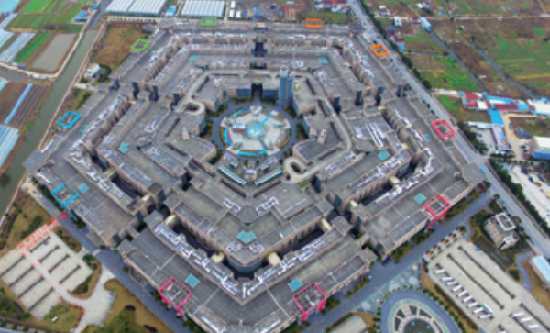
 |
|
The vacant Pentagonal Mart outside Shanghai. PROVIDED TO CHINA DAILY |
It looks like China and the US share a phenomenon of the internet age: dinosaur malls.
Sprawling shopping malls served as a community gathering place for many towns across the US in the latter half of the 20th century, with their heyday extending from the 1960s to 1990s.
But along came the internet, and suddenly everyone was using the term bricks-and-mortar to describe the suddenly anachronistic, enclosed plazas.
In the United States, the ruthless competition emerged in the form of online behemoths such as Amazon and eBay.
In China, it's Alibaba and its subsidiaries Taobao and Tmall, along with competitor JD.com.
But many of the US malls already were middle-aged by the time online shopping exploded. In China, many malls were just being built - and still are.
"Too many properties have been built in China during recent years, and ... commercial properties such as shopping malls have been overdeveloped," said Pan Shiyi, chairman of SOHO China, a Beijing-based property developer.
Pan, who spoke last Tuesday in Hong Kong as SOHO China released interim financial results, said that he had visited five cities, where many shopping malls are facing difficulties.
The traditional shopping mall is "under siege" from e-commerce, and the plight of "ghost malls" is evident in third- and fourth-tier cities, Hui Jianqiang, research director with real estate information provider Beijing Zhongfangyanxie Technology Service, told the Global Times.
In second-tier cities like Qingdao, Shenyang and Tianjin, more than 10 percent of retail space is vacant, global real estate firm CBRE reported.
On the outskirts of the first-tier city of Shanghai sits the vacant Pentagonal Mart, a replica of US Defense Department headquarters - but twice as big. The 123-acre site is the largest vacant building in China, according to People's Daily, which noted that it has been abandoned because of its location and "confusing inner structures".
Perhaps the most famous ghost mall is the South China Mall in Dongguan, Guangdong province, which was 99 percent vacant for several years after its 2005 opening. Now, however, it is 80 percent occupied, thanks to a makeover focused on dining.
"Under pressure from changing consumer preferences for good services and a total shopping experience, as well as competition from the online model, shopping malls need to transform and upgrade themselves to win back shoppers by combining shopping with entertainment," Hui noted.
Hui said the longer-term outlook is brighter amid China's urbanization drive, which will gradually bring foot traffic to new downtown malls in growing cities.
More than 50 percent of new shopping centers completed in 2016 were forced to delay their grand openings by more than six months, CBRE noted in a July report.
China has more than 4,500 malls, four times the US total. The country's retail boom has been driven by construction spending and local governments seeking to build their tax base, cbsnews.com reported.
Chinese also are more likely to shop online than people in other countries, according to PwC, and they prefer using their smartphones. Eighty percent of online purchases in China last year were done via a mobile device.
Only 46 percent say they shop at brick-and-mortar stores with the same frequency, CBS reported. They're also more likely to use mobile phones than people in other countries.
In the US, mall anchors such as Macy's, J.C. Penney and Sears have closed hundreds of stores. Another mall-dependent chain, The Limited, a women's clothing retailer, announced in January that it would close all 250 of its US stores. Once-trendy teen retailer Abercrombie & Fitch is suffering from a drop in mall foot traffic.
Macy's, however, will probably maintain a physical presence. The host of the fabled Thanksgiving parade regularly reports annual net income of $1 billion.
The decline of the mall doesn't necessarily mean it's game over for brick-and-mortar retail, according to a report released on Wednesday by research firm IHL Group, Debunking the Retail Apocalypse.
"The negative narrative that has been out there about the death of retail is patently false," said Greg Buzek, president of IHL Group. "The so-called 'retail apocalypse' makes for a great headline, but it's simply not true.
"Over 4,000 more stores are opening than closing among big chains, and when smaller retailers are included, the net gain is well over 10,000 new stores," he said, adding that retail sales were up $121.6 billion through July.
It's also a matter of changing consumer preferences. The IHL report found that the fastest-growing retail segments are off-price retailers and dollar stores, convenience stores and grocery retailers.
"Without question, retail is undergoing some fundamental changes. The days of 'build it and they will come' are over," Buzek said.
Contact the writer at williamhennelly@chinadailyusa.com